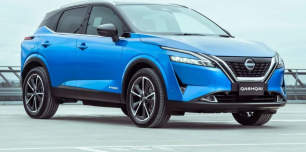Two things are obvious soon after the driver presses the starter and silently whooshes away in a Qashqai Ti e-Power.
Firstly, there’s a real weight to it, highlighting this as a solid (as well as heavy) vehicle of substance. And, secondly, once over this initial impression, everything then seems completely normal and intuitive. There’s nothing alien going on here.
Despite the mass, acceleration is brisk, with throttle response becoming even livelier once on the move, since you can feel all that instant torque on tap, even with a light flex of your right foot.
Pushing down harder, it should soon become clear this is a fast machine, so keep an eye on that digital speedo display. It caught us out a couple of times during our test drive through central Victoria.
Using the driving modes reveals varying behaviour according to the settings. In Eco mode the e-Power has a smooth and relaxed gait; performance is Normal seems more spirited while in Sport responses are appropriately stronger and more urgent.
It’s worth keeping the latter in mind, because the chassis is set up for a sporty, Euro feel, meaning there’s a tautness to the suspension that's a little at odds with the plushness of the interior. This isn’t a soft, bouncy ride.
Rolling on a 235/50 R19 wheel and tyre package, there’s a pleasing balance of steering feel, handling agility and roadholding grip, resulting in a dynamically athletic and reassuringly controlled vehicle, even at speed through tighter corners. However, as with the e-Power’s acceleration delivery, the keener driver has to first push through a level of inertia to discover this.
One trait worth keeping in mind is that the tail can become loose and even slide out a little before the ESC quickly yet calmly reels it back in, if you attempt to take a bend too fast. Beware, though, that as the roads were hot and dry during our drive, we cannot attest to how this behaviour will manifest in the wet. Should be fun if you’re a keener driver. We weren’t expecting that.
What else? The easy e-Pedal function works well, providing significant braking up to a point, without bringing the vehicle to a full stop. It soon feels second nature.
Plus, unlike most Toyota hybrids, many EVs and even the X-Trail Ti e-Power we tested recently, the smaller-brother Qashqai avoids that oddly wooden brake-pedal feel, though again, a test in inner-urban traffic may reveal something else.
And, finally, over coarse-chip surfaces, there’s a bit too much tyre or road-noise intrusion coming inside, though over the smoother stuff, you’ll also feel blissfully cocooned in the comfort the Ti packaging provides.
Overall, then, the Qashqai e-Power is a swift, agile and entertaining drive, as well as safe and secure, revealing a further depth to Nissan’s engineering talent and capability.





































